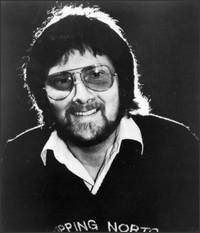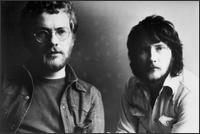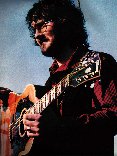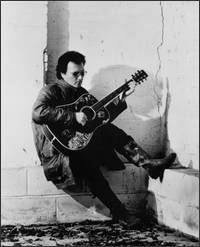Bruce
Eder
All Music Guide
Gerry Rafferty was a popular music
giant at the end of the 1970's, thanks to the
song "Baker Street" and the album City
To City. His career long predated that fixture of
top 40 radio, however - indeed, by the time he
cut "Baker Street", Rafferty had
already been a member of two successful groups,
the Humblebums and Stealers Wheel.
Gerry Rafferty was born in Paisley,
Scotland in 1947, the son of a Scottish mother
and an Irish father. His father was deaf but
still enjoyed singing, mostly Irish rebel songs,
and his early experience of music was a
combination of Catholic hymns, traditional folk
music, and 50's pop music.

By 1968, at age 21, Rafferty was a
singer-guitarist and had started trying to write
songs professionally, and was looking for a gig
of his own. Enter Billy Connolly, late of
Scottish bands like the Skillet-Lickers and the
Acme Brush Company. Connelly was a musician and
comedian, who'd found that telling jokes from the
stage was as appealing an activity to him-and the
audience-as making music. He'd passed through
several groups looking for a niche before finally
forming a duo called the Humblebums with Tam
Harvey, a rock guitarist. They'd established
themselves in Glasgow, and were then approached
by Transatlantic, one of the more successful
independent record labels in England at the time,
and signed to a recording contract. After playing
a show in Paisley, Rafferty approached Connelly
about auditioning some of the songs he'd written.
Billy Connelly was impressed not only with the
songs but with their author, and suddenly the
Humblebums were a trio.

The Humblebums trio was a major
success in England, both on stage and on record,
but not without some strain. Connelly was the
dominant personality, his jokes between the songs
entertaining audiences as much as the songs
themselves. Additionally, Rafferty began develop
a distinctive style as a singer-guitarist and
songwriter, and this eventually led to tension
between him and Harvey-the latter exited in 1970,
and Rafferty and Connelly continued together for
two more albums, their line-up expanding to a
sextet, but their relationship began to break
down. The records were selling well, and the gigs
were growing in prominence, including a Royal
Command Performance. Connelly, however, worked
himself to the point of exhaustion amid all of
this activity, and when he did recover, he and
Rafferty ultimately split up over the differing
directions in which each was going. Rafferty had
noticed that Connelly's jokes were taking up more
time in their concerts than the music he was
writing. They parted company in 1971.

Transatlantic didn't want to give up
one of its top money-makers, however, especially
if there was a new career to be started. Rafferty
cut his first solo album for the label that year.
Can I Have My Money Back? was a melodious
folk-pop album, on which Rafferty employed the
vocal talents of an old school friend, Joe Egan.
The LP garnered good reviews but failed to sell.

Out of those sessions, however,
Rafferty and Egan put together the original
line-up of Stealers Wheel, which was one of the
most promising (and rewarding) pop-rock outfits
of the mid-1970's. Unfortunately, Stealers
Wheel's line-up and legal history were
complicated enough to keep various lawyers well
paid for much of the middle of the decade.
Rafferty was in the group, then out, then in
again as the line-up kept shifting-their first
album was a success, the single "Stuck In
The Middle With You" a huge hit, but nothing
after that clicked commercially, and by 1975 the
group was history. Three years of legal battles
followed, sorting out problems between Rafferty
and his management.

Finally, in 1978, Rafferty was free
to record again, and he signed to United Artists
Records. That year, he cut City To City, a
melodic yet strangely enigmatic album that topped
the charts in America, put there by the success
of the song "Baker Street." The song
itself was a masterpiece of pop production,
Rafferty's Paul McCartney-like vocals carrying a
haunting central melody with a mysterious and
yearning lyric, backed by a quietly thumping
bass, tinkling celeste, and understated keyboard
ornamentation, and then Raphael Ravenscroft's
sax, which we've had a taste of in the opening
bars, rises up behind some heavily amplified
electric guitars-it was sophisticated '70s
pop-rock at its best [and better yet, it wasn't
disco! -- author's note], and it dominated the
airwaves for months in 1978, narrowly missing the
No. 1 spot in England but selling millions of
copies and taking up hundreds of cumulative hours
of radio time. The publisher and the record
company couldn't have been happier. Everyone
concerned was thrilled, until it became clear
that Rafferty -- who had a reclusive and
iconoclastic streak -- was not going to tour
America to support the album. The album, which
hit No. 1, might've gone double-platinum and
meant it (lots of records were shipped platinum
in those days, only eventually to return 90% of
those copies) had Rafferty toured.


His next record, Night Owl (1979),
also charted well and got good reviews, but the
momentum that had driven City to City to
top-selling status wasn't there, and Snakes and
Ladders (1980), his next record, didn't sell
nearly as well. Ironically, around this time,
Rafferty's brother Jim was signed to a recording
contract by Decca-London, a label that wasn't
long for this world -- something that Gerry would
soon have to face about his own situation at
United Artists. United Artists Records had seen
some major hit records throughout the '60s and
'70s, but by the end of the decade, the parent
film distribution and production company was
revamping all of its operations, in the wake of
the mass exodus of several of its top executives.
The record label was one of the first things to
go -- running a record company was a luxury that
the current UA management felt it could do
without. Rafferty was practically the last major
artist signed to the label, and if City To City
had been a hit when the label was sold to EMI,
he'd probably have been treated like visiting
royalty. But by the time United Artists Records
was sold to EMI around 1980, his figures weren't
showing millions of units sold anymore. His
contract was merely part of a deal, and, in fact,
almost none of the UA artists picked up by EMI
fared well with the new company -- as with many
artists caught up in one of those
sale-and-acquisition situations, even if Rafferty
had been producing anything comparable to
"Baker Street" in popularity, it's
doubtful the record would've gotten the push it
would've taken to make it a hit.

Sleepwalking (1982), issued on the
Liberty label, ended that round of Rafferty's
public music-making activities, and he was little
heard from during the mid-1980's, apart from one
song contributed to the offbeat comedy Local
Hero, a producer's gig with the group the
Proclaimers that yielded a top 3 single
("Letter From America") in 1987.

A year later, he released his first
album in more than five years, North And South,
which failed to register with the public. By that
time, Transatlantic had begun exploiting his
early recording activity, reissuing his early
solo and Humblebums tracks on CD.


On A Wing And A Prayer (1992) was
similarly ignored by the public, although the
critics loved it, and Over My Head (1995) was an
attempt to reconsider his own past by re-thinking
some Stealers Wheel-era songs.
Gerry Rafferty is still remembered,
two decades after it was a hit, primarily for
"Baker Street" and City To City, which
have been released as gold-plated audiophile CDs.
And every so often, when some Stealers Wheel
track gets picked up for some soundtrack (as
"Stuck In The Middle With You" was for
Quentin Tarantino's Reservoir Dogs) or
commercial, his voice and guitar also get a fresh
airing.
|
|
Jerry
Gilbert
Liner Notes from
"Right Down the Line"
The classic pop song had no greater
ambassador throughout the 1970s than Gerry
Rafferty.

Ironically the greatest charge to
his work was when he was battling the music
business -- the innate fire and passion of the
Scotsman pouring forth on the cool, manipulative
machinations of the record industry in London; it
was a classic 'city to city' confrontation, a
fact which he readily acknowledged in the title
of his most successful album.
But if Gerry Rafferty was often his
own worst enemy then the beneficiaries were a
growing army of fans who were to push
international sales of City to City above 5.5
million.
Gerry Rafferty arrived in London in
1969 having replaced Tam Harvey alongside Billy
Connolly in The Humblebums. For a while their
different musical backgrounds provided a fertile
counterpoint and yielded two collectors albums
but when, in Gerry's words "Billy's jokes
were getting longer and longer, the songs shorter
and shorter", it was time to go their
separate ways.
The miraculous low-budget solo album
Can I Have My Money Back? (another provocative
title) fulfilled the contract with Trans-Atlantic
and set in progress a long, fruitful relationship
with producer Hugh Murphy.

It was during the second phase of
his career that Gerry Rafferty was to gain his
first taste of commercial success after forming
Stealers Wheel with Joe Egan, whom he'd first met
on the Glasgow pop scene when he was 17. The band
should also have featured fife folk luminary Rab
Noakes with Gerry and Roger Brown in a British
answer to Crosby, Stills, Nash and Young, but
Noakes pulled out, to be followed by a series of
personnel changes. True to form, Stuck in the
Middle With You, which was a stateside #1 and a
song which Paul Simon at the time remarked was
his favourite pop song, was conceived as a
tongue-in-cheek lampoon on a farcical management
pre-signing party for record execs.
"The party was held in a
fashionable restaurant in London. We all sat at a
huge long table, like one of those scenes from
the Last Supper. A few days later Joe Egan and I
wrote this humerous little ditty about everyone
getting out of it, never thinking it would go to
number one in America", Rafferty recalls,
"But in some ways it was our downfall
because it put a lot of pressure on us."
Refusing to tour the States and
generally "play the industry game", he
left the band and returned to Scotland as the
collapse of their management company eventually
brought the curtain down -- some would say
prematurely, some would say for the best -- on
Stealers Wheel's chequered four-year run.
Unfettered by managment or musician
problems, Gerry Rafferty was now to embark on the
most consistently productive period of his
career. He had left London disillusioned and
licking his wounds, but back in the bosom of his
family he was soon ready to demo five or six
songs in Edinburgh and set off in search of the
recording deal that was to lead him to United
Artists.
"I knew I'd written a good
bunch of songs so I called Hugh Murphy and we
recorded at Chipping Norton. I remember thinking
I'd be pleased if City to City solf 50,000
copies" he recalls. It sold five and a half
million, delivered arguably the best pop song of
the year in Baker Street and certainly the most
memorable sax intro of all time, although Raphael
Ravenscroft's line had actually been written and
performed by Rafferty on the original demo of the
song."

Both he and Murphy knew they had an
outstanding track but felt it too esoteric to
foist on a record company and indeed United
artist pre-empted its release with the album's
title track before a groundswell from among the
ranks at UA demanded its inevitable single
status.
The shadow of melancholy now seemed
to rise like a weight from Gerry Rafferty's
shoulders. Baker Street was an instant smash and
he went on tour with the core of top session team
that had made City to City -- men like Tommy
Eyres, Gary Taylor, Hi=ugh Burns, Jerry Donahue,
and Henry Spinetti.
The album was slow to move but by
the time they reached Belgium they learnt that it
had finally gone top ten in America. Still Gerry
refused tpo tour the States but conceded to make
a single appearance on the David Frost Show --
which catapulted City to City straight to the top
spot. The album's success was duly reinforced by
sales of the next single Right Down the Line,
which was another Transatlantic hit.
Gerry now decided to leave home base
in Scotland once again and return to the
south-east of England. Through 1979 he was
writing and recording Night Owl in a period of
frenzied output. His creative juices turning out
songs like the title track and the unforgettable
Get It Right Next Time, which both chalked up
bigger successes the other side of the Atlantic
where his FM/AOR formula was perfectly suited to
American audio ears. With very little promotional
back up, Night Ol reached a sales aggregate of
2.5 million units.
Inevitably this album was to be the
turning point. Financially secure on the one hand
and the "production line" pressure to
turn out hits on the other, Gerry Rafferty was
feeling creatively spent by the time he sat down
to produce Snakes and Ladders. Having lost the
desire to manufacture chart hits he went to
George Martin's studio in Montserrat and
delivered one of his best socio-political
polemics in The Garden of Englad (on the CD
version of this compilation), as well as Look at
the Moon (on the vinyl version) and a beautifully
remixed Bring It All Home.

But if The Garden of England best
summed up Gerry Rafferty's Snakes and Ladders
mood, a song called The Right Moment fulfilled
that position on the subsequent Sleepwalking
album -- a song considered by the artist to be
among the best he'd ever written.
Finding himself at the crossroads
and looking to replace the treadmill with a new
dimension in his life he built a recording studio
at his Kent farm and by the time Sleepwalking was
released by EMI in 1983, following their takeover
of UA, he and his family were off on the road --
living for a year in Italy, then driving across
America. "I enjoyed travelling outside the
confines of the music business. But eventually my
puritanical streak emerged once again so I
settled down, set up a home studio and started to
write and record.
Working once again with co-producer
Hugh Murphy, the resulting North and South album
showed the song writer to be back to his
hungriest and most creative.
The autobiographical title again
dwelling on the dichotomy between the years
living in and around London and his genuine need
to stay in touch with his Celtic roots.

So enjoy this superb compilation of
Gerry Rafferty's compilation of Gerry Rafferty's
best songs, inparticular the remixes of Baker
Street, Whatever's Written in Your Heart, and
Bring It All Home.
|

